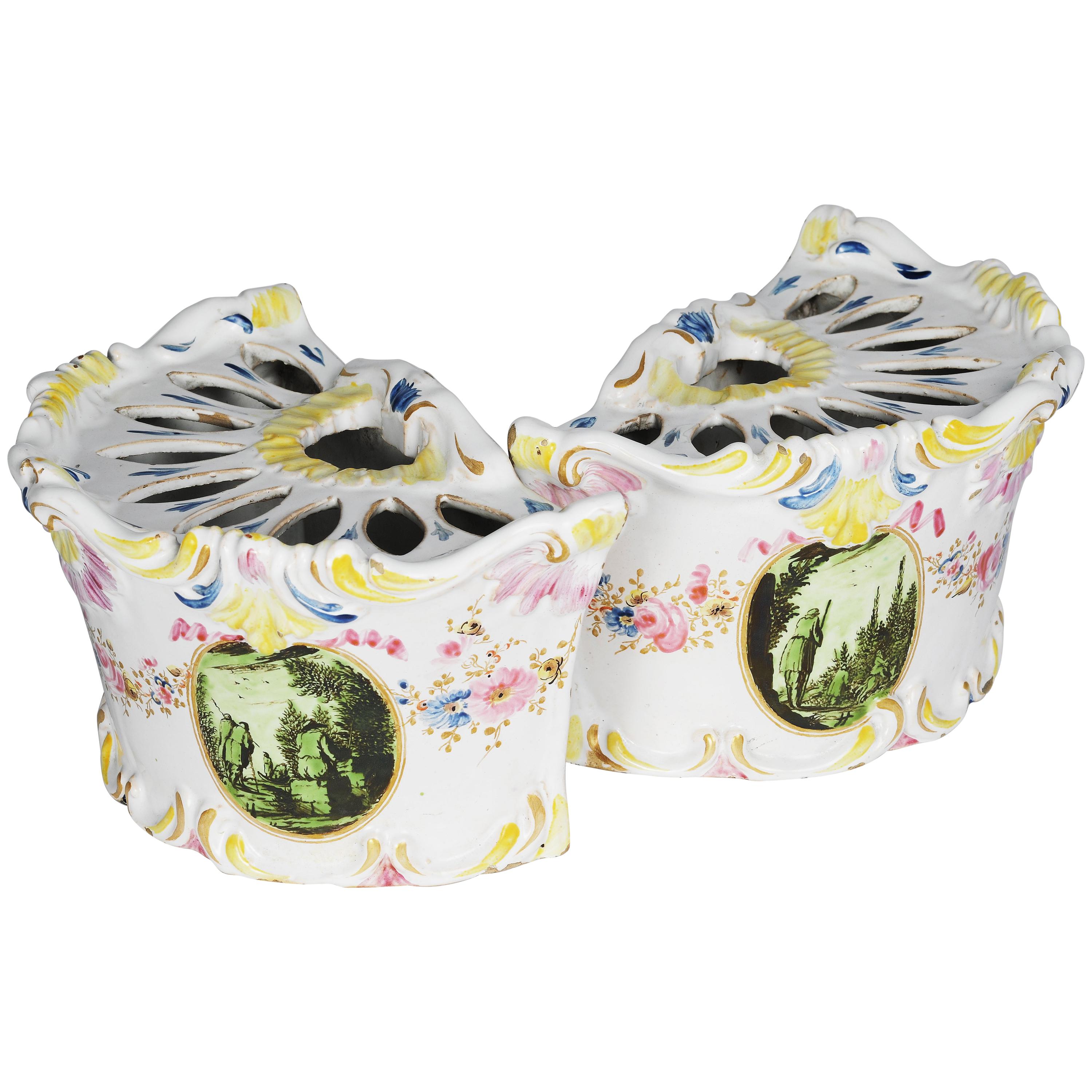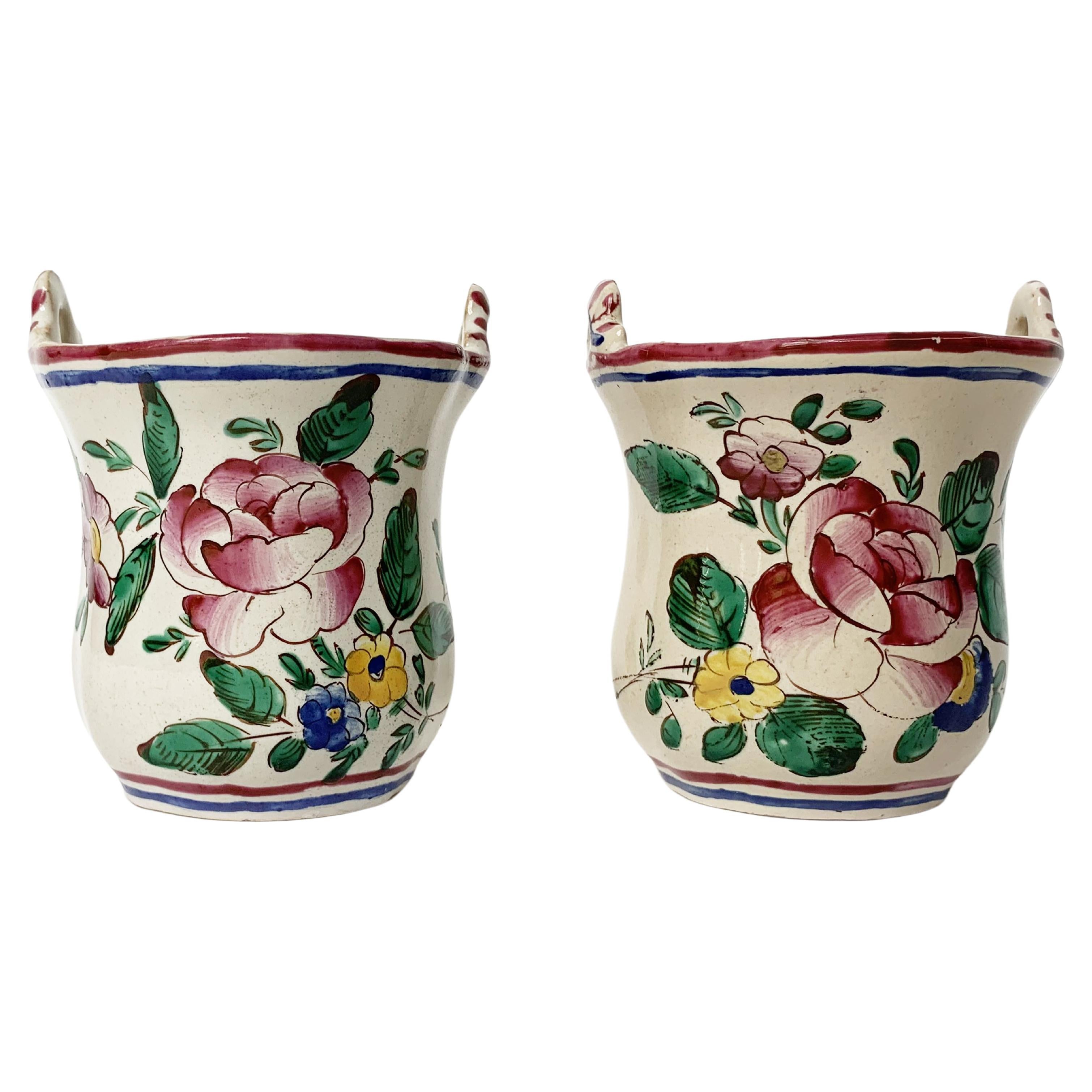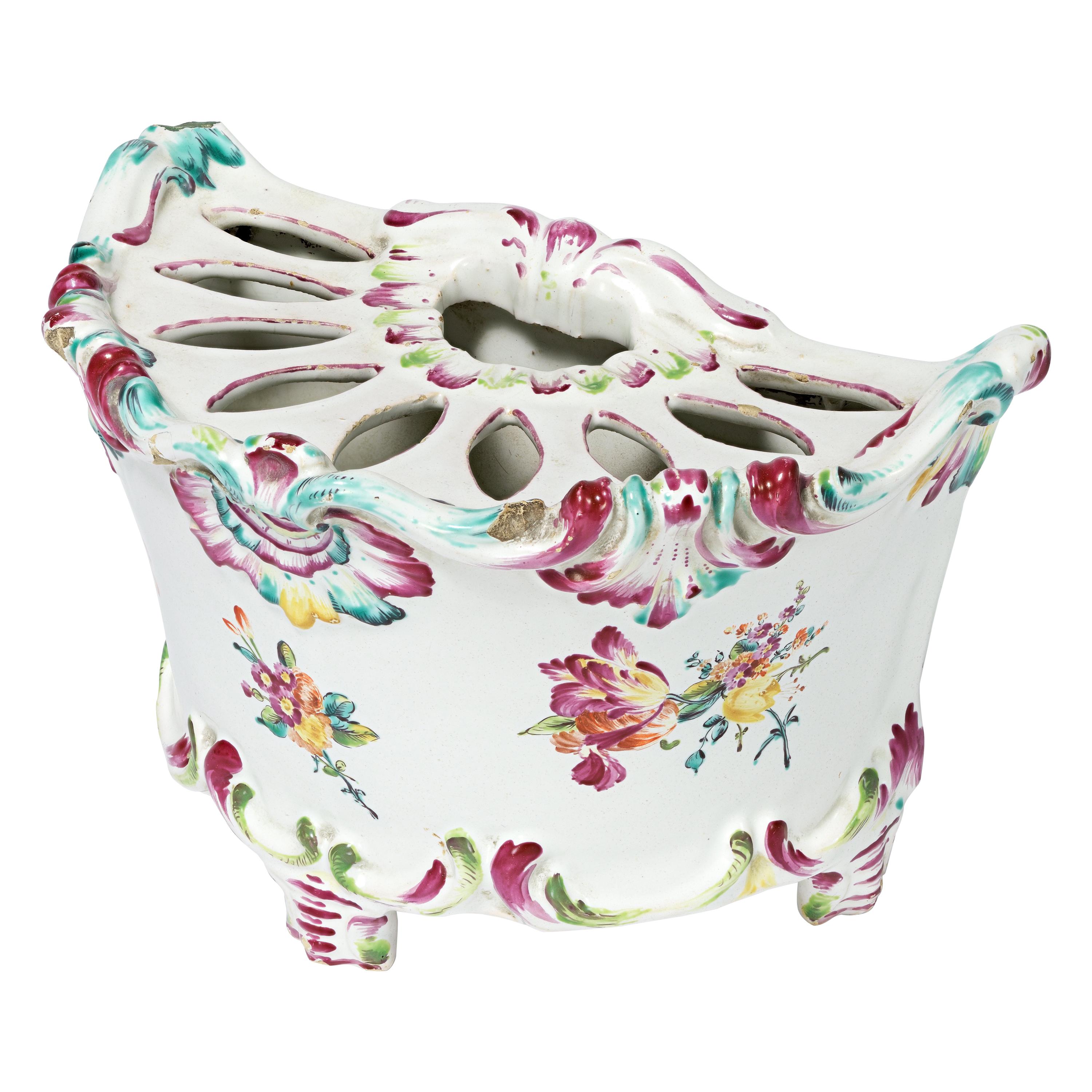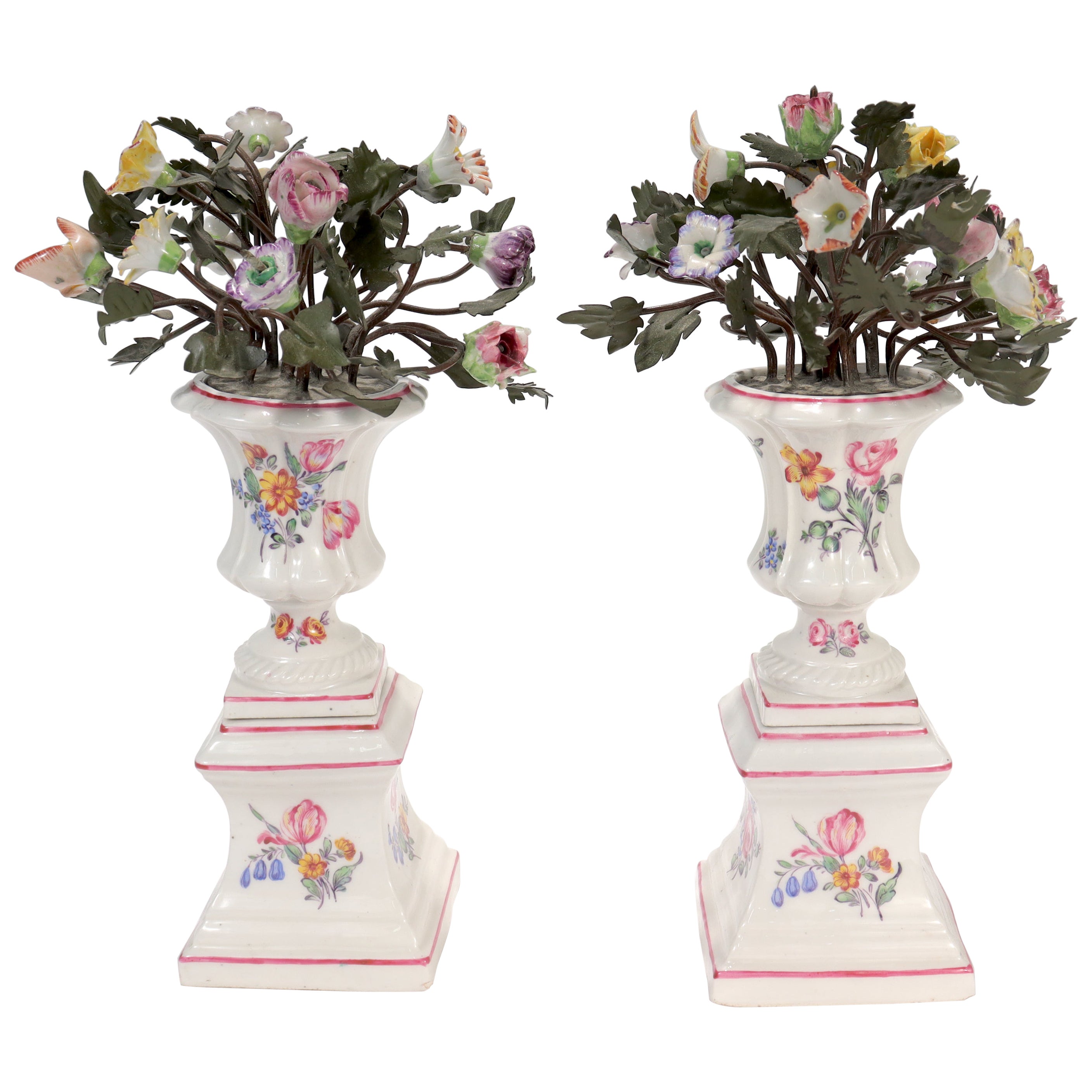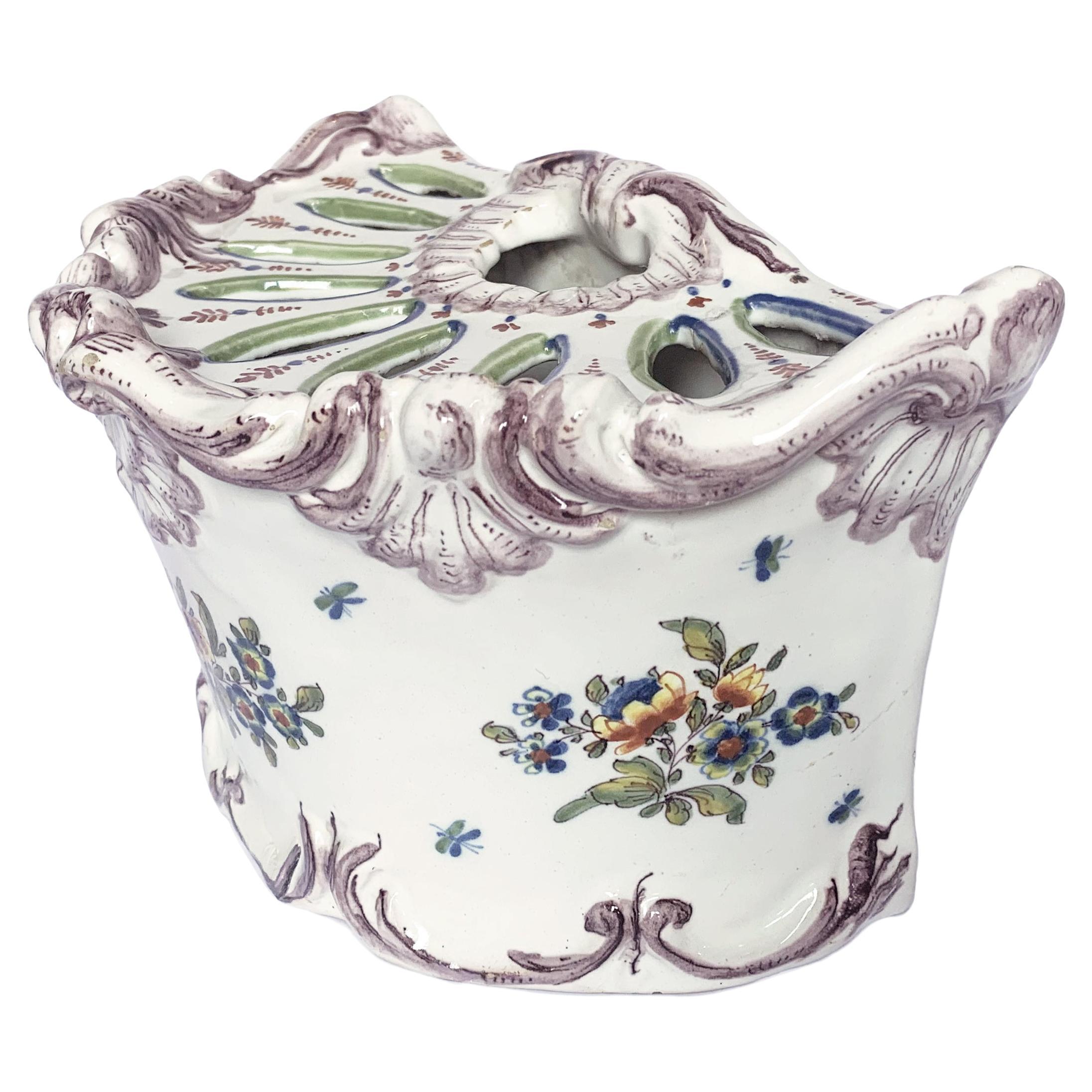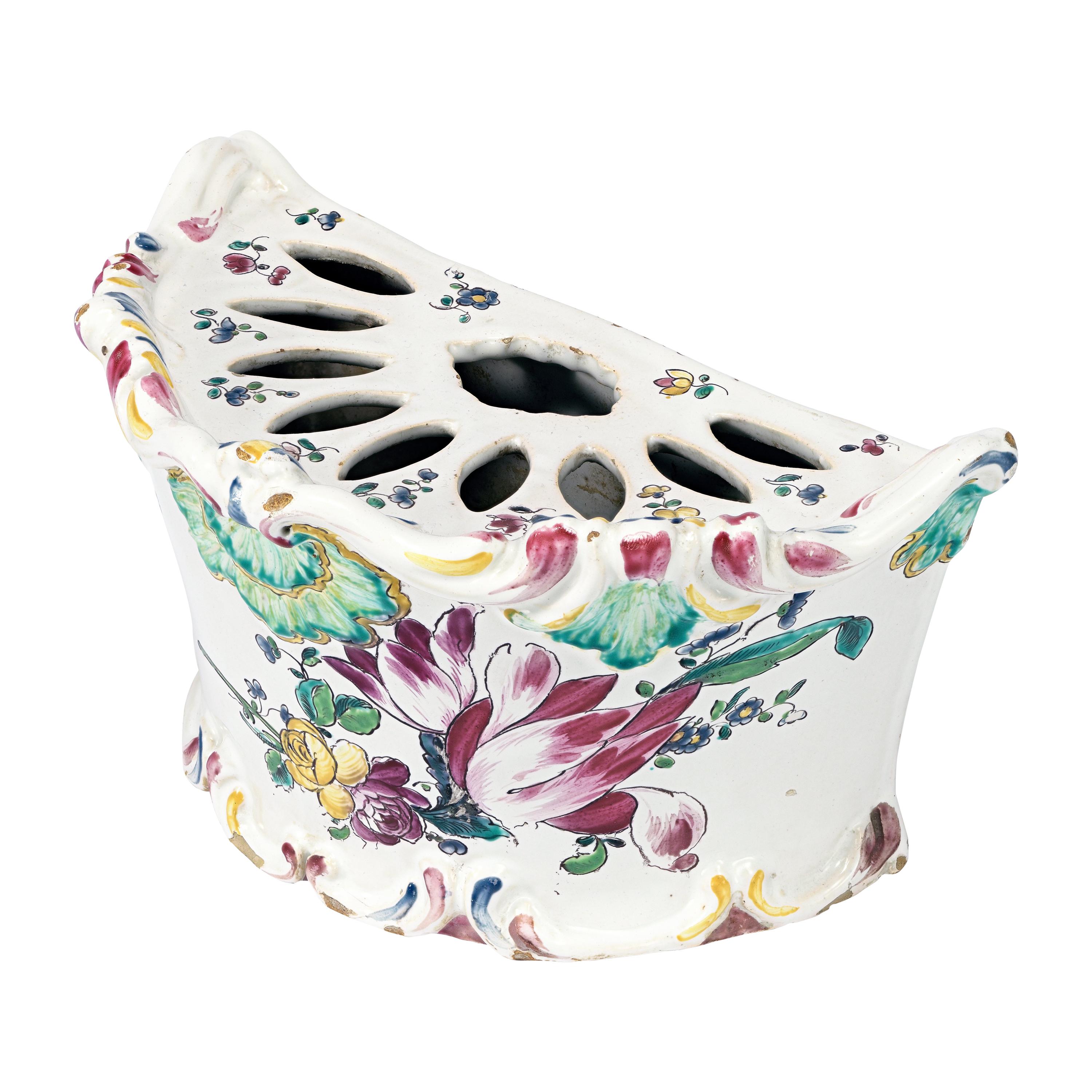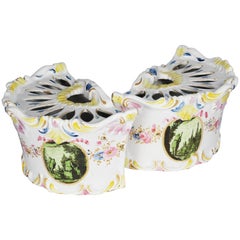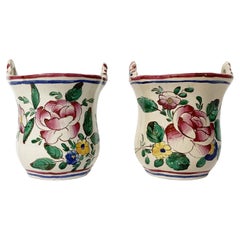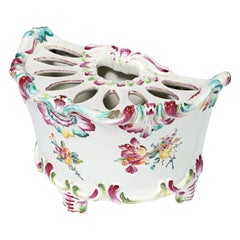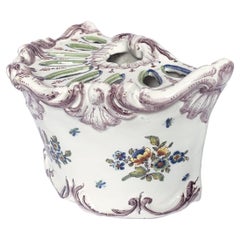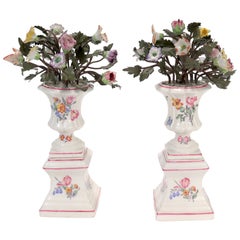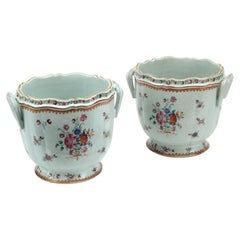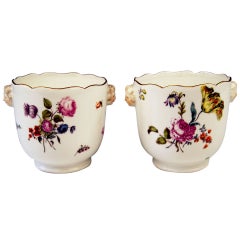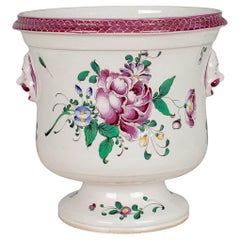Items Similar to Maiolica flower pots Samson & Fils Factory, France, late 19th century
Video Loading
Want more images or videos?
Request additional images or videos from the seller
1 of 21
Maiolica flower pots Samson & Fils Factory, France, late 19th century
$1,919.89per set
£1,415.85per set
€1,600per set
CA$2,651.36per set
A$2,909.17per set
CHF 1,522.52per set
MX$35,802.02per set
NOK 19,181.52per set
SEK 17,966.35per set
DKK 12,185.97per set
About the Item
Maiolica flower pots “a mezzaluna”
Samson & Fils Factory
Montreuil-sous-Bois, France, late 19th century
They measure 4.72 in in height x 8.66 x 5.03 (12 cm x 22 x 12,8)
Weight: 1.88 lb each (856 g)
State of conservation: intact with slight chipping due to use in relief parts
A rare example of a flower pot “a mezzaluna” produced by the manufactory of Samson around the end of the 18th century. This is demonstrated by the small double S signature placed next to the writing “Sceaux” in italics under the base and flanked by the decorative number “5”.
The maiolica is decorated with a rocaille relief to adorn the edges. The upper part is perforated in a radial pattern to contain and support the flowers. This mold, which was also produced with a different morphology in France, is consistent with that used by the Milanese factories of the eighteenth century (for comparisons see the planters of the Castello Sforzesco Museum in Milan, R. Ausenda, a cura di, Musei e Gallerie di Milano. Museo d’Arti Applicate. Le ceramiche. Tomo secondo, Milano 2001, pp. 425, nn. 409 e n. 41).
The decoration shows, in the center of the vase, two bouquets which occupy the main part of the semicircle and which are accompanied by small bunches of rosebuds and minor florets rendered in full polychrome. The floral bouquets, in which the purple color predominates, stand out from the usual compositions since they resemble, in terms of decorative taste, the products of contemporary European porcelain manufactories, including that of Sceaux.
Careful observation of the vases, which bear, as mentioned above, the brand of the "Sceaux" manufacture, therefore reveals an inconsistency: the shape is typical of eighteenth-century manufactures in Milan, in particular that of Pasquale Rubati, but the main brand and the decoration are consistent with the works of French manufacturing. The explanation is provided by the presence of the small brand, associated with the previous one, in which the characteristic double "S" mark of the great nineteenth-century French ceramist Emile Samson (1837-1913) appears, certifying its paternity. Therefore, not only are the pair of maiolica flower pots the work of Samson, but they document the presence in his manufacture of 18th century Milanese works, which, as in this case, were mistaken for artefacts from the Sceaux factory. Another similar case among the Samson manufactory collections had already been recognized by scholars (R. Ausenda, op. cit, p. 326): a tureen similar to Milanese productions had been found.
The two flower pots therefore constitute a fixed point in the history of Emile Samson's manufacturing studies after 1891, attesting to the creative methods of his production lines and providing important information which identify his sources of inspiration.
The Samson "Porcelain, maiolica and terracotta factory" began its activity with Edmé Samson (1810-1891), a ceramic decorator, who opened his own factory in 1845 at number 7 rue Vendôme in Paris. His business lasted for four generations: their creations perfectly document the taste of the times, as well as demonstrate how much the attraction to the styles of previous periods - especially that of the 18th century - influenced the 19th and early 20th centuries. The factory was constantly busy and followed all sorts of clients. It produced ceramics ranging from maiolica and porcelain to earthenware, and in a variety of styles including that of the Renaissance and Spain, as well as Saxony and the Far East. Indeed, the production represents a perfect example of the advent of Historicism.
Emile (1837-1913) worked alongside and then succeeded his father Edmé, in making reproductions of old porcelains. These were all judged to be of excellent quality at the major exhibitions of the time, including the Universal Exhibition in Paris in 1867. It was also at that moment that the manufacture, which had become Samson & Cie, moved to Montreuil-sous-Bois, near Paris, and increased its production volumes. Further recognition came during the Universal Exhibition of 1889, especially thanks to the creation of large-scale works of both maiolica and porcelain: his models came from the largest French and foreign museums, such as the Louvre Museum or the Victoria & Albert Museum in London. Emile in 1891, with his son Léon (1868-1928), continued the business under the name of Samson & Fils, with great success and increased production. The activity then continued for other generations and with new perspectives until at least the 1980s.
Bibliography:
R. Ausenda, a cura di, Musei e Gallerie di Milano. Museo d’Arti Applicate. Le ceramiche. Tomo secondo, Milano 2001
F. Slitine, Samson, génie de l'imitation, Issy-les-Moulineaux 2002.
- Creator:Emile Samson (Maker)
- Dimensions:Height: 4.73 in (12 cm)Width: 8.67 in (22 cm)Depth: 5.04 in (12.8 cm)
- Sold As:Set of 2
- Style:Rococo (In the Style Of)
- Materials and Techniques:
- Place of Origin:
- Period:
- Date of Manufacture:Circa 1895
- Condition:Wear consistent with age and use. Intact with slight chipping due to use in relief parts.
- Seller Location:Milano, IT
- Reference Number:1stDibs: LU4352239225602
About the Seller
4.3
Vetted Professional Seller
Every seller passes strict standards for authenticity and reliability
Established in 1860
1stDibs seller since 2018
21 sales on 1stDibs
Associations
International Confederation of Art and Antique Dealers' Associations
- ShippingRetrieving quote...Shipping from: Milano, Italy
- Return Policy
Authenticity Guarantee
In the unlikely event there’s an issue with an item’s authenticity, contact us within 1 year for a full refund. DetailsMoney-Back Guarantee
If your item is not as described, is damaged in transit, or does not arrive, contact us within 7 days for a full refund. Details24-Hour Cancellation
You have a 24-hour grace period in which to reconsider your purchase, with no questions asked.Vetted Professional Sellers
Our world-class sellers must adhere to strict standards for service and quality, maintaining the integrity of our listings.Price-Match Guarantee
If you find that a seller listed the same item for a lower price elsewhere, we’ll match it.Trusted Global Delivery
Our best-in-class carrier network provides specialized shipping options worldwide, including custom delivery.More From This Seller
View AllPair of Ancient Italian Maiolica Flower Pots Milan, Rubati Factory, 1770 circa
By Pasquale Rubati
Located in Milano, IT
Maiolica flower pot “a mezzaluna”
decorated with trompe l’oeil
Pasquale Rubati Factory
Milan, circa 1770
Measures: each 4.7 in (cm 12) x 5 in (c...
Category
Antique 1770s Italian Rococo Ceramics
Materials
Maiolica
Small Maiolica Flower Pots, Ferretti Manufacture, Lodi, circa 1770-1780
By Antonio Ferretti
Located in Milano, IT
Two maiolica flower pots
Antonio Ferretti Manufacture
Lodi, Circa 1770 - 1780
Maiolica polychrome decorated “a piccolo fuoco” (third fire)
The...
Category
Antique 1770s Italian Rococo Ceramics
Materials
Maiolica
Rococo Italian Maiolica Flower Pot Pasquale Rubati, Milano, 1770 circa
By Pasquale Rubati
Located in Milano, IT
Maiolica flower pot “a mezzaluna” with support feet
decorated with little bunches of flowers
Pasquale Rubati Factory
Milan, circa 1770
5.5 in X ...
Category
Antique 1770s Italian Rococo Ceramics
Materials
Maiolica
Maiolica flower pot "a mezzaluna," Pasquale Rubati Factory, Milan, circa 1770
By Pasquale Rubati
Located in Milano, IT
Majolica flower pot "crescent" decorated in manganese
Pasquale Rubati Factory
Milan, c. 1770
4.92 in x 8.66 in x 5,31 in
12.5 cm x 22 cm X 13.5 cm
Weight: 2.29 lb (1039 g)
State of conservation: intact with slight chipping due to use in relief parts
A rare example of a flower pot "a mezzaluna" produced by the manufactory of the refined painter Pasquale Rubati, who opened a factory in Milan in 1756 to compete with Felice Clerici...
Category
Antique 1770s Italian Rococo Ceramics
Materials
Maiolica
Ancient Maiolica Flower Pot Pasquale Rubati Factory, Milan Circa 1770
By Pasquale Rubati
Located in Milano, IT
Maiolica flower pot “a mezzaluna” decorated with tulip
Pasquale Rubati Factory
Milan, circa 1770.
Measures: 4.7 in x 4.7 in x 8.6 in
12 cm x 12...
Category
Antique 1770s Italian Rococo Ceramics
Materials
Maiolica
Italian Maiolica Flower Pot Garlands of Flowers, P. Rubati, Milano, 1770 circa
By Pasquale Rubati
Located in Milano, IT
Maiolica flower pot “a mezzaluna”
decorated with garlands of flowers
Pasquale Rubati Factory
Milan, circa 1770
Measures: 4.7 in x 5 in x 8.8 in
...
Category
Antique 1770s Italian Rococo Ceramics
Materials
Maiolica
You May Also Like
Pair Antique Samson Mennecy Style Tole Peinte & Porcelain Flower Vases/Cachepots
By Samson Porcelain Factory 1
Located in Philadelphia, PA
A fine pair of Samson tole peinte & porcelain flower vases or cachepots.
In the 18th Century Mennency style.
In the form of porcelain urns or vases hand painted with floral motifs ...
Category
Early 20th Century French Rococo Planters, Cachepots and Jardinières
Materials
Tin
Pair of Chinese Export Polychrome Porcelain Cachepots, 18th Century
Located in El Monte, CA
This pair of 18th century Chinese Export polychrome porcelain cachepot are an exceptional example of antique porcelain made by skilled Chinese artisans for the European market. A sca...
Category
Antique 18th Century Chinese Chinese Export Planters, Cachepots and Jard...
Materials
Porcelain
Meissen Pair of Cachepots Planters Flower Blossoms Rococo Period c. 1750
By Meissen Porcelain
Located in Vienna, AT
Meissen gorgeous pair of cachepots / planters stunningly decorated with flower blossoms, made in Rococo Period / circa 1750.
The white porcelain ...
Category
Antique 18th Century and Earlier German Rococo Porcelain
Materials
Porcelain
$2,855 Sale Price / set
29% Off
French Lunéville Saint Clément Faience Cache Pot
By Luneville
Located in Winter Park, FL
French faience Lunéville Saint Clément cache pot, or planter. Hand-painted in typical floral design with vivid colors of pink, green, purple, ...
Category
Mid-20th Century French French Provincial Planters, Cachepots and Jardin...
Materials
Ceramic, Faience
19th Century French Majolica Flowers Jardiniere Onnaing
By Onnaing
Located in Austin, TX
19th Century French Majolica Flowers Jardiniere Onnaing.
Category
Antique 1890s French Art Nouveau Planters, Cachepots and Jardinières
Materials
Ceramic
19th Century English Majolica Floral Jardiniere Minton
By Minton
Located in Austin, TX
19th Century Rare English Majolica Floral Jardiniere signed Minton.
H / 7.2 inches , Diameter / 10.5 inches.
Category
Antique 1880s English Victorian Planters, Cachepots and Jardinières
Materials
Ceramic
More Ways To Browse
Old Factory
French Rococo Vases
Rococo Flower
Antique Samson Porcelain
Samson French
Pair Of Tureens
Perforated Ceramic
Perforated Vase
Rosebud Antique
Edme Samson
Pair Old Paris Porcelain Vases
Paris Porcelain Tureen
Rare Flower Pots
Large Porcelain Pot Planters
Japanese Early 19th Century Planters
Jardiniere Wmf
Large Mirrored Planter
Pickle Jar
